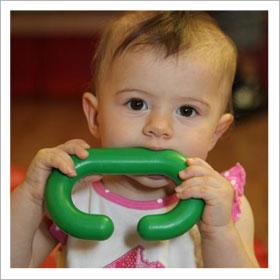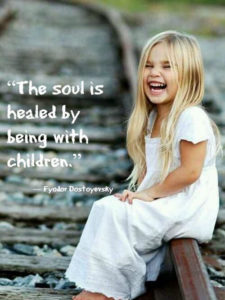From the Principal’s Desk:
Understanding and Responding to Children Who Bite
Biting is a typical behavior often seen in infants, toddlers, and 2-year olds. As children mature, gain self-control, and develop problem-solving skills, they usually outgrow this behavior. While not uncommon, biting can be an upsetting and potentially harmful behavior. It’s best to discourage it from the very first episode. This article will help you to understand the reasons young children bite and give you some ideas and strategies for responding appropriately.
A child might bite to:
- Relieve pain from teething.
- Explore cause and effect (“What happens when I bite?”).
- Experience the sensation of biting.
- Satisfy a need for oral-motor stimulation.
- Imitate other children and adults.
- Feel strong and in control.
- Get attention.
- Act in self-defense.
- Communicate needs and desires, such as hunger or fatigue.
- Communicate or express difficult feelings, such as frustration, anger, confusion, or fear (“There are too many people here and I feel cramped”).
What can families do to prevent biting?
There are a variety of things that families can do to prevent biting. It helps to
- Have age-appropriate expectations for your child’s behavior based on his or her current skills and abilities.
- Make sure your child’s schedule, routines, and transitions are predictable and consistent. At meal and bedtimes, try to do things in the same way and at the same times. Young children thrive when they know what will happen next.
- Offer activities and materials that allow your child to relax and release tension. Some children like yoga or deep breathing. Offer playdough, foam balls, bubbles, soft music, and other stress-reducing items.
- Use positive guidance strategies to help your child develop self-control. For example, offer gentle reminders, phrased in a way that tells them what behaviors are expected.
- Provide items to bite, such as teething rings or clean, wet, cold washcloths stored in the refrigerator. This helps children learn what they can bite safely, without hurting anyone else.
How should I respond when my child bites?
While every situation is different, here are some general guidelines for responding when a child bites.
Infants
Infants learn about the world around them by exploring it with their hands, eyes, and mouths. But infants often need help to learn what they should and shouldn’t bite.
If your infant takes an experimental bite on a mother’s breast or grandpa’s shoulder, stay calm and use clear signals to communicate that it is not okay for one person to bite another. A firm “no” or “no biting!” is an appropriate response.
Toddlers and Preschoolers
Toddlers have many strong emotions that they are just learning to manage. Toddlers may bite to express anger or frustration or because they lack the language skills needed to express their feelings.
Biting is less common in preschoolers than toddlers. When a preschooler bites, it may be due to something at home or at their child care program that is causing the child to be upset, frustrated, confused, or afraid. A preschooler may also bite to get attention or to act in self-defense.
Follow the steps below with both toddlers and preschoolers.
- If you see the biting incident, move quickly to the scene and get down to children’s level. Respond to the child who did the biting. In a serious, firm tone make a strong statement: “No biting. Biting hurts. I can’t let you hurt Josie or anyone else.” Next, offer a choice: “You can help make Josie feel better, or you can sit quietly until I can talk with you.” Help the child follow through on the choice if necessary.
- Respond to the child who was hurt by offering comfort through words and actions: “I’m sorry you are hurting. Let’s get some ice.” Perform first aid if necessary. The child who did the biting can help comfort the bitten child—if both parties agree. Help the child who was hurt find something to do.
- Finally, talk to the child who did the biting. Maintain eye contact and speak in simple words using a calm, firm tone of voice. Try to find out what happened that led to the incident. Restate the rule, “Biting is not allowed.” Model the use of words that describe feelings: “Kim took your ball. You felt angry. You bit Kim. I can’t let you hurt Kim. No biting.” Discuss how the child can respond in similar situations in the future.
What if biting becomes a habit for my child?
If biting becomes a habit for your child and ongoing positive guidance is not effective, it is time to set up a meeting with your child’s teacher(s). Together, you can plan an approach for addressing the behavior that can be applied consistently at home and at the program. Together, you can discuss and define the behavior and find the cause behind it. Next, you and the teacher(s) can develop a plan to address the causes and help your child to replace biting with acceptable behaviors. Try the plan for several weeks, but be patient. It takes time to change behaviors that have become habits. Keep in touch with your child’s teacher(s) to share information about changes in behavior. After several weeks, evaluate the plan’s effectiveness and make changes as needed.
What strategies can I use to help my child overcome a habit of biting?
Here are some strategies for addressing a child’s biting habit.
- Observe your child to learn where, when, and in what situations biting occurs. Sometimes an adult may need to stay close to the child to prevent biting.
- Pay attention to signals. Stay close and step in if your child seems ready to bite.
- Suggest acceptable ways to express strong feelings. Help your child learn to communicate her wants and needs (“Amy, tell your sister you were still playing with the truck”).
- Use a reminder system to help your child learn to express strong feelings with appropriate words and actions (“Tell Manuel that you don’t like it when he gets that close to you”).
- Reinforce positive behavior by acknowledging child’s appropriate words and actions (“You didn’t like being tickled so you used your words to ask me to stop”).
- Provide opportunities for your child to make choices and feel empowered.
- Be sure your behavior expectations are age-appropriate and individually appropriate for your child. Expecting a child to do something he or she is not able to do can cause children to feel stress. Stress can lead to biting.
- Offer foods with a variety of textures to meet your child’s sensory needs.
- Teach your child words for setting limits, such as “no,” “stop,” or “that’s mine.”
What strategies are not helpful?
These strategies should not be used to address a child’s biting habit.
- Avoid labeling a child as a “biter.” Negative labels can affect how you view your child, and even affect the child’s feelings about him- or herself.
- Never bite a child back to punish or show him how it feels to be bitten. Biting a child sends the message that using violence is an acceptable behavior that can be used to solve problems.
- Avoid getting angry, yelling, or shaming a child.
- Avoid giving too much attention to a child who bites after an incident. While this is usually negative attention, it can still reinforce the behavior and cause a child to repeat it.
- Do not force a child who bit and the child who was hurt to play together.
- Do not punish children who bite. Punishment does not help children to learn discipline and self-control. Instead, it makes children angry, upset, defiant, and embarrassed. It also undermines the relationship between you and your child.
Source: Adapted from D. Koralek, “Understanding and Responding to Biting,” In Classroom Strategies to Promote Children’s Social and Emotional Development, 135–138. Lewisville, NC: Kaplan Press, 1999. © 1999 The Devereux Foundation, Villanova, Pennsylvania.
Inspirational Quotes for parents


A summer of innovation and fun for curious minds…Summer Camp!
As a continuation of our Links to Learning® curriculum, Preschool camp offers a fun-filled summer program for children 1 to 5. Each week preschoolers jump into action, participating in fun and exciting activities and special events.
Our preschoolers have the opportunity to expand their horizons during the summer, embarking on new adventures, and having fun! We create a summer experience that is unforgettable!
Although we want the children to have the best summer possible, we can’t forget about all they’ve learned during the school year.
Our Links to Learning ® summer curriculum is designed to review and strengthen skills taught during the school year. Various academic activities will be integrated throughout your child’s daily summer experience.
Our camp program will inspire your child’s mind to engage, explore, create and stay active this summer!
Please Click Here to access the August activity calendar.

Parent Reminders

August Newsletter
From the Principal’s Desk:
Understanding and Responding to Children Who Bite
Biting is a typical behavior often seen in infants, toddlers, and 2-year olds. As children mature, gain self-control, and develop problem-solving skills, they usually outgrow this behavior. While not uncommon, biting can be an upsetting and potentially harmful behavior. It’s best to discourage it from the very first episode. This article will help you to understand the reasons young children bite and give you some ideas and strategies for responding appropriately.
A child might bite to:
What can families do to prevent biting?
There are a variety of things that families can do to prevent biting. It helps to
How should I respond when my child bites?
While every situation is different, here are some general guidelines for responding when a child bites.
Infants
Infants learn about the world around them by exploring it with their hands, eyes, and mouths. But infants often need help to learn what they should and shouldn’t bite.
If your infant takes an experimental bite on a mother’s breast or grandpa’s shoulder, stay calm and use clear signals to communicate that it is not okay for one person to bite another. A firm “no” or “no biting!” is an appropriate response.
Toddlers and Preschoolers
Toddlers have many strong emotions that they are just learning to manage. Toddlers may bite to express anger or frustration or because they lack the language skills needed to express their feelings.
Biting is less common in preschoolers than toddlers. When a preschooler bites, it may be due to something at home or at their child care program that is causing the child to be upset, frustrated, confused, or afraid. A preschooler may also bite to get attention or to act in self-defense.
Follow the steps below with both toddlers and preschoolers.
What if biting becomes a habit for my child?
If biting becomes a habit for your child and ongoing positive guidance is not effective, it is time to set up a meeting with your child’s teacher(s). Together, you can plan an approach for addressing the behavior that can be applied consistently at home and at the program. Together, you can discuss and define the behavior and find the cause behind it. Next, you and the teacher(s) can develop a plan to address the causes and help your child to replace biting with acceptable behaviors. Try the plan for several weeks, but be patient. It takes time to change behaviors that have become habits. Keep in touch with your child’s teacher(s) to share information about changes in behavior. After several weeks, evaluate the plan’s effectiveness and make changes as needed.
What strategies can I use to help my child overcome a habit of biting?
Here are some strategies for addressing a child’s biting habit.
What strategies are not helpful?
These strategies should not be used to address a child’s biting habit.
Source: Adapted from D. Koralek, “Understanding and Responding to Biting,” In Classroom Strategies to Promote Children’s Social and Emotional Development, 135–138. Lewisville, NC: Kaplan Press, 1999. © 1999 The Devereux Foundation, Villanova, Pennsylvania.
Inspirational Quotes for parents
A summer of innovation and fun for curious minds…Summer Camp!
As a continuation of our Links to Learning® curriculum, Preschool camp offers a fun-filled summer program for children 1 to 5. Each week preschoolers jump into action, participating in fun and exciting activities and special events.
Our preschoolers have the opportunity to expand their horizons during the summer, embarking on new adventures, and having fun! We create a summer experience that is unforgettable!
Although we want the children to have the best summer possible, we can’t forget about all they’ve learned during the school year.
Our Links to Learning ® summer curriculum is designed to review and strengthen skills taught during the school year. Various academic activities will be integrated throughout your child’s daily summer experience.
Our camp program will inspire your child’s mind to engage, explore, create and stay active this summer!
Please Click Here to access the August activity calendar.
Parent Reminders
ANCILLARY PROGRAMS
Monday Morning: Daisy Dance is a ballet, tap and a creative movement dance program designed to teach children a life long love of movement and provide a foundation for all dance genres. New dance sessions will begin in September. Click here for the registration form.
Tuesday Afternoon: T.O.T (Teams of Tomorrow) is an awesome training program that focuses on basketball handling and dribbling skills. The onsite classes are fun, educational and active. New TOT classes will start September 7th. Click here for the registration forms.
Thursday Morning: Soccer Shots is a popular non-competitive youth soccer program. This program teaches confidence, fun, character, teamwork, coordination and imagination. The summer soccer shots will start September 1st- Nov. 17th. A new session will start in the fall, click here for a registration form
Friday Morning: King Tiger Tae Kwon Do is taught according to individual needs and levels of skills. Students begin to establish, and actually achieve, personal goals. Students learn that, by setting realistic goals and applying dedication and hard work, anything is possible. They develop confidence! The virtues of Respect, Concentration, Discipline, and Motivation are the characteristics of a truly confident individual. A new session will start in the fall, click here for the registration form.
From our Education Department
How to Handle "I'm Bored"
Read More »